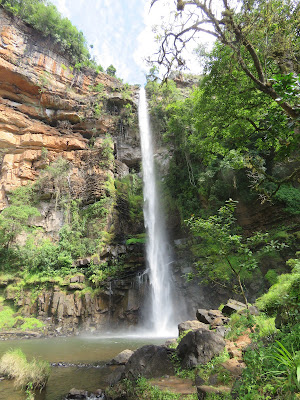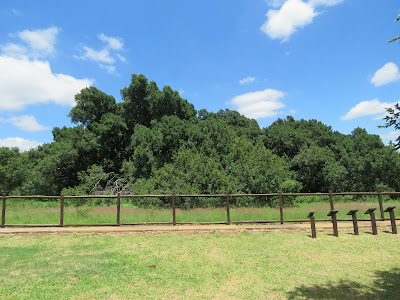Marievale near Nigel is always a good birding spot and it's proximity is reason enough for a visit. Though not abundant, there were a few small flocks of lesser flamingos, whose bright pink wing panels burst into spectacular view when they took flight - though this guy was more interested in breakfast.

Us Bishop's do love to dress up to impress the ladies and this yellow-crowned example was doing his best, but didn't appear to be having much luck.

Not nearly as gaudy but impeccably groomed was this Levaillant's cisticola who was titivating in the early sunshine.

On another morning I went to do some atlassing near Suikerbosrand Nature Reserve which was closed due to lock-down regulations. Happened to notice this fellow doing sentry duty up a pylon with his tail awfully close to an 11 kV power line. Expected a flash and bang at any moment.

Located an old quarry next to the road which was teeming with birds, including a pair of fulvous whistling ducks, which I haven't seen since Jo and I visited the now defunct Rondebult Nature Reserve, at least 15 years ago.
A bank on the side of the road was home to these grasses which showed a slight purple tinge in the early light.
As the day warmed up brown-veined whites in their hundreds collected nectar prior to proceeding with their mass migration. It's a one way journey across South Africa in a north easterly direction and they lay eggs before departure or on the way and then are either nabbed by predators, or end up in the sea off the east coast. Explanations have yet to be provided - PhD anyone!
There is one thing that the highveld does very well ......and that's clouds. Most afternoons at this time of year they amass into towering banks and unleash thunderstorms of majestic proportion. These were gathering over the highest point in Gauteng, which is in Suikerbosrand.
A report came in of not one but two Madagascar cuckoos visiting our shores, one in Hluhluwe and one in Soetdoring near Bloemfontein, the latter being the closest. I spent the night in a nearby cottage and tried to get to the spot on the afternoon that I arrived. Torrential rain and a period of being stuck in mud ended the visit - thank heavens for diff lock or the night would have been less than comfortable. On arrival the next morning, I found I was not alone...............................

Chasing the distinctive four note call led us on a merry dance which eventually ended back at the vehicles, where the majority of the spectators had good views of the bird.......................I wasn't one of them. Latching on to the youngest (good eyes) of those who missed out, we went crashing into an acacia thicket and eventually nailed the sod. Thus ended a search which has been going on since 2005 when Jo and I heard but didn't see the bird in Kruger. All I can say is that if it wasn't calling, how the heck would you separate it from the 4 other species that look nearly identical?
I had been in contact Vivienne, Fudge's niece who was somewhat surprisingly living in Whiteriver and as we were both keen to catch up, I hit the road with the big red on the back. Once again the highveld provided a rather pleasing painted sky.

I spent the night with Viv and her husband then headed for Sabie and all those wonderful passes. As it was still a bit early I drove out to Lone Creek Falls to try and get a picture of a yellow-streaked greenbul that I had encountered there on a previous visit. Heard it but could not find it, the falls made up for it though........
..........but I was itching to ride. A few decades back, some wag advertised in Bike SA that he was selling the R536 between Sabie and Hazyview and I'm sure he must have been inundated. This has to be the ultimate bikers road with dozens of fast left and right sweeps and the odd tight corner to get the adrenaline going. I really surprised myself on one of those when my shoe touched the tar! There's also this lovely spot off the R537, where I was about to take a dip, but a family arrived with a picnic.....so had to get dressed.
This serpentine stretch leads up to Pilgrim's Rest, which now lives up to the "grim" part of it's name unfortunately. So many passes......so little time.
Friend Jane did a little jolly to Thornybush and then by Rovos back to Pretoria and needed a lift, so I obliged and collected her at their very swanky private station in Pretoria.

The 2 hour delay (caused by Transnet being intractable) gave me time to snoop and it is very impressive but way out of my league.

I'd suggested a visit to Dinokeng Nature Reserve, a place I've never been to, which is about 60 km north of Pretoria and is reputed to have the big five. Jane found, among a multitude of places to stay, a very pleasant and reasonable two bedroom cottage at The Chameleon Bush Lodge (I think).
Dinokeng was formed by a bunch of farmers who amalgamated over 160 properties and source labour for the various lodges, etc from nearby villages. It's rather odd as there is a busy road right through it, a school and and small shopping mall. The birdlife was great but the only unusual animals we saw were a pair of hyenas.
A group of pied babblers visited the cottage but the best I could do was this guy preening or contemplating his navel. The male of pair of red-billed fire-finches was kind enough to allow this shot........
....................whilst a spotted (note the stripes!) flycatcher seemed to be wondering what I was up to.
There was some time to kill between check out and Jane's flight so we did the tourist thing with a visit to the Wonderboom, a massive clump of Ficus salicifolia that have spread from a mother tree - now deceased.
The surrounding daughters formed where the mother tree's branches touched the ground and rooted, a process which is being repeated to form grand-daughters etc.
Just before leaving Boksburg, the clouds formed what appeared to be an interesting sunset so I launched Titus the drone, though it was not epic. As most of my school reports said "Could do better".
The road to Hlalanathi skirts the beautiful Sterkfontein Dam which is always this amazing aquamarine colour....
..........and the surrounding mountains lend a unique charm to the place.
At the top end, just before the Oliviershoek Pass, is a smaller dam called Driekloof, which is the top reservoir of the Drakensberg pumped storage scheme. In off peak times (if there ever are any with Eskom in it's current state) the generators are reversed and water from the Tugela River is pumped up to supply the ever needy Gauteng region. The wall is just visible below the hill in the center of the picture. The difference between the turbid waters of the Tugela is readily apparent, though Sterkfontein is so full currently that there is very little flow past the wall.
That difference is even more apparent from the top of the pass where the Kilburn Dam holds the water that will be pumped up the escarpment. The Tugela feeds the Woodstock Dam in the distance and water from there is relayed back to Kilburn via a canal. The whole system is reversed during peak demand and water from Driekloof flows downwards to generate much needed electricity.
And so to Hlalanathi where I have booked in for a month to keep well clear of Covid and the rest of the world, a few of the chalets are visible on the ridge and the campsite is tucked away under shady trees - blissful.
Shortly after my arrival, the Beast was quickly invaded by small black caterpillars looking for a safe place to pupate. After a week or so they began to emerge and as their wings dried and unfurled were revealed to be garden acraeas
In a previous blog I posted a picture of a plant I wasn't able to identify as I lacked my library. Richard Boon came to the rescue and provided this mouthful. Xysmalobium undulatum. More commonly known as Milkwort it is used extensively medicinally both here and abroad, where is marketed as Uzura.
I happened to be near the spot again and found that the flowers had been replaced by these hairy pods, with a visiting fly for comparative size purposes! The pods split open eventually and the seeds, carried by fluffy parachutes, drift away - provided they haven't been collected by the locals to be used as pillow stuffing that is.
Coming back from a ride one morning I happened to notice something that requires just the right conditions to be visible. The second highest waterfall in the world where the nascent Tugela tumbles over the wall of the Amphitheater and drops 948 m to the floor below. The reason I'd missed it before is that it is normally a trickle but was now flowing strongly and from around mid-morning that section of the wall is in shade
A closer view reveals the single largest drop of 186 m fairly close to the top.

































Great blog as usual...but Dave, I haven't noticed you dressing up for the ladies!!
ReplyDelete